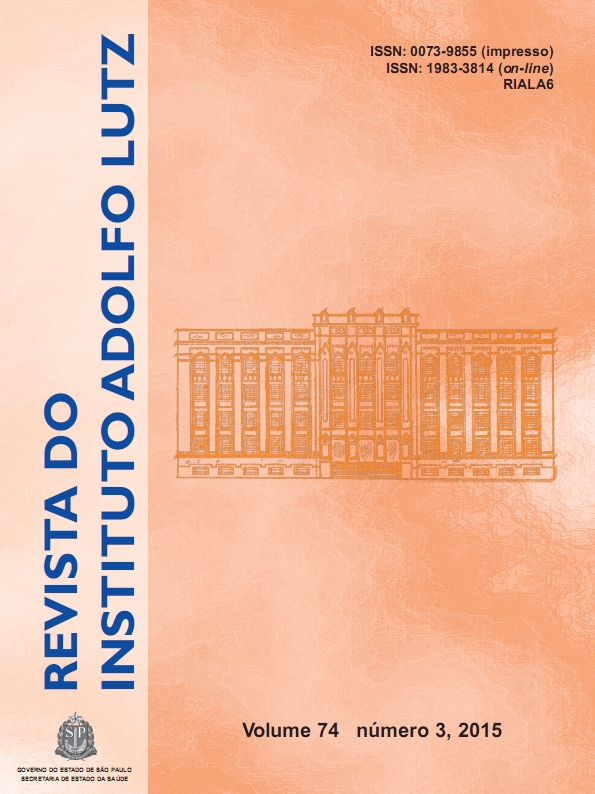Abstract
The objective of this study was to evaluate the antimicrobial activity of different concentrations of essential oil (EO) of Cymbopogon flexuosos on the standard strains of Staphylococcus aureus, Escherichia coli and Salmonella Choleraesuis adhered to the stainless steel surface AISI 304 #4. Initially, the minimum inhibitory concentrations (MIC) and the minimum bactericidal concentrations (MBC) were determined by means of EO macrodilution broth assay. Subsequently, the adhesion and the biofilm formation on stainless steel surface were evaluated for 15 h at 37 °C under agitation, and also the OE sanitizing action against adherent cells on the coupons after 20 and 40 min of contact. The MIC value found for all species was 7.5 μL.mL-1, which is the concentration used for preparing the sanitizing solution. A complete removal of adhered cells of E. coli and S. Choleraesuis occurred after being exposed during both periods of time. The adhered cells of S. aureus were not removed; however, a reduction in the number of adhered cells was detected when compared to that quantity showed before being subjected to sanitizing treatments. The EO of C. flexuosus might be an alternative for microbial control in surfaces during food processing.
References
1. Oliveira DCV. Produção de biofilmes por Salmonella sp. isolada de frango [dissertação de mestrado]. Botucatu (SP): Universidade Estadual Paulista; 2011.
2. Millezzi AF. Ação de óleos sobre biofilmes formados por Staphylococcus aureus e Escherichia coli [tese de doutorado]. Lavras (MG): Universidade Federal de Lavras; 2012.
3. Rossi ACR, Porto E. A importância da elaboração de procedimentos de higienização considerando a presença de biofilmes. SBCC.2009;março/abril:40-1.
4. Nascimento HM, Delgado DA, Barbaric IF. Avaliação da aplicação de agentes sanitizantes como controladores do crescimento microbiano na indústria alimentícia. Rev Ceciliana.2010;2(1):11-3.
5. Lebert I, Leroy S, Talon R. Effect of industrial and natural biocides on spoilage, pathogenic and technological strains grown in biofilm. Food Microbiol. 2007;24(3):281-7. [DOI: 10.1016/j.fm.2006.04.011].
6. May A, Bovi AO, Maia NB, Moraes ARA, Pinheiro MQ, Mario M. Influência do intervalo entre cortes sobre a produção de biomassa de duas espécies de capim limão. Hortic Bras.2008;826(3):379-82. [DOI: 10.1590/S0102-05362008000300017].
7. Bakkali F, Averbeck S, Averbeck D, Idaomar M. Biological effects of essential oils: a review. Food Chem Toxicol.2008;46(2):446-75. [DOI: 10.1016/j.fct.2007.09.106].
8. Oliveira MMM. Óleos essenciais no controle de biofilmes bacterianos: Listeria monocytogenes e Echerichia coli enteropatogênica [tese de doutorado]. Lavras (MG): Universidade Federal de Lavras; 2011.
9. National Committee for Clinical Laboratory Standards – NCCLS. Metodologia dos Testes de Sensibilidade a Agentes Antimicrobianos por Diluição para Bactéria de Crescimento Aeróbico: Norma Aprovada. 6ª ed. Norma NCCLS M7-A6; 2003.
10. Rossoni EMM, Gaylarde CC. Comparison of sodium hypochlorite and peracetic acid as sanitising agents for stainless steel food processing surfaces using epifluorescence microscopy. Int J Food Microbiol. 2000;61(1):81-5. [DOI: 10.1016/S0168-1605(00)00369-X].
11. Oliveira MMM, Brugnera DF, Cardoso MG, Alves E, Piccoli RH. Disinfectant action of Cymbopogon sp. essential oils in different phases of biofilm formation by Listeria monocytogenes on stainless steel surface. Food Control.2010;21(4):549-53. [DOI: 10.1016/j.foodcont.2009.08.003].
12. American Public Health Association – APHA. Standard methods for the examination of water and wastewater. 21ª ed. Washington: American Water Works, Water Environment Federation; 2005.
13. Valeriano C, Oliveira TL, Carvalho SM, Cardoso MG, Alves E, Piccoli RH. The sanitizing action of essential oil-based solutions against Salmonellaenterica serotype Enteritidis S64 biofilm formation on AISI 304 stainless steel. Food Control.2012;25(2):673-7. [DOI: 10.1016/j.foodcont.2011.12.015].
14. Careli RT, Andrade NJ, Soares NF, Júnior JIR, Rosado MS, Bernardes PC. The adherence of Pseudomonas fluorescens to marble, granite, synthetic polymers, and stainless steel. Cienc Tecnol Aliment.2009;29(1):171-6. [DOI: 10.1590/S0101-20612009000100026].
15. Statistical Analysis System – SAS. SAS/ETS user’s guide. Version 9.0 ed. Cary: SAS Institute; 2010.
16. Adukwu EC, Allen SCH., Phillips CA. The anti-biofilm activity of lemongrass (Cymbopogon flexuosus) and grapefruit (Citrus paradisi) essential oils against five strains of Staphylococcus aureus. J Appl Microbiol.2012;113(5):1217-27. [DOI: 10.1111/j.1365-2672.2012.05418.x].
17. Brugnera DF, Oliveira MMM, Piccoli RH. Essential oils of Cymbopogon sp. in the control of foodborne pathogenic bacteria. Alim Nutr. 2011;22(3):339-43.
18. Fennell CW, Lindsey K L, Mc Gaw LJ, Sparg SG, Stafford GI, Elgorashi EE, et al. Assessing African medicinal plants for efficacy and safety: pharmacological screening and toxicology. J Ethnopharmacol.2004;94(2-3):205-17. [DOI: 10.1016/j.jep.2004.05.012].
19. Andrade NJ, Bridgman TA, Zottola EA. Bacteriocidal activity of sanitizers against Enterococcus faecium attached to stainless steel as determined by plat count and impedance methods. J Food Prot. 1998;61(7):833-8.
20. Oulahal N, Brice W, Martial A, Degraeve P. Quantitative analysis of survival of Staphylococcus aureus or Listeria innocua on two types of surfaces: polypropilene and stainless steel in contact with three different dairy products. Food Control. 2008;19(2):178-85. [DOI: 10.1016/j.foodcont.2007.03.006].
21. Brabes KCS. Identificação de capacidade de adesão de Staphylococcusspp. isolados de manipuladores, superfícies e ar de ambientes de uma indústria de laticínios [tese de doutorado]. Viçosa (MG): Universidade Federal de Viçosa; 2005.
22. Boari CA, Alves MP, Tebaldi VM, Savian TV, Piccoli RH. Formação de biofilme em aço inoxidável por Aeromonas hydrophila e Staphylococcus aureus usando leite e diferentes condições de cultivo. Cienc Tecnol Aliment.2009;29(4):886-95.
23. Joseph B, Otta SK, Karunasagar I, Karunasagar I. Biofilm formation by Salmonella spp. on food contact surfaces and their sensitivity to sanitizers. Int J Food Microbiol.2001;64(3):367-72. [DOI: 10.1016/S0168-1605(00)00466-9].
24. Chavant P, Martinie BG, Talon R, Hébraud M, Bernardi T. A new device for rapid evaluation of biofilm formation potential by bacteria. J Microbiol Methods. 2007;68(3):605-12. [DOI: 10.1016/j.mimet.2006.11.010].
25. McDonnel G, Russel, D. Antisseptics and disinfectants: acttivity, action and resistence. Clin Microbiol Rev.1999;12(1):147-79.
26. Sander JE, Hofacre CL, Cheng IH, Wyatt RD. Investigation of resistance of bacteria from commercial poultry sources to commercial disinfectants. Avian Dis.2002;46(4):997-1000.

This work is licensed under a Creative Commons Attribution 4.0 International License.
Copyright (c) 2016 Instituto Adolfo Lutz Journal
